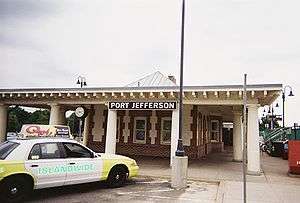Port Jefferson station (LIRR)
Port Jefferson is the terminus for the Port Jefferson Branch of the Long Island Rail Road. The station is located on New York State Route 25A (Main Street), on the north side of the tracks, but is also accessible from Oakland Avenue (both of which are in the Village of Port Jefferson), as well as Railroad Avenue and Union Street on the south side of the tracks in Port Jefferson Station. All service is diesel-only, and most off-peak trains are shuttles requiring a transfer to an electric train at Huntington or Hicksville. This train station is located in the Brookhaven-Comsewogue Union Free School District.
Port Jefferson | |||||||||||||||
|---|---|---|---|---|---|---|---|---|---|---|---|---|---|---|---|
 2007 parking lot view | |||||||||||||||
| Location | NY 112 (Main Street) & Oakland Avenue Port Jefferson Station, New York | ||||||||||||||
| Coordinates | 40°56′4.99″N 73°3′13.29″W | ||||||||||||||
| Owned by | Long Island Rail Road | ||||||||||||||
| Platforms | 1 side platform | ||||||||||||||
| Tracks | 4 | ||||||||||||||
| Connections | |||||||||||||||
| Construction | |||||||||||||||
| Parking | Yes | ||||||||||||||
| Bicycle facilities | Yes | ||||||||||||||
| Disabled access | Yes | ||||||||||||||
| Other information | |||||||||||||||
| Fare zone | 10 | ||||||||||||||
| History | |||||||||||||||
| Opened | 1873 | ||||||||||||||
| Rebuilt | 1875, 1903, 1968, 2001, 2019 | ||||||||||||||
| Traffic | |||||||||||||||
| Passengers (2006) | 1,793[2] | ||||||||||||||
| Services | |||||||||||||||
| |||||||||||||||
| Former services | |||||||||||||||
| |||||||||||||||
The station also serves Suffolk County Transit buses and occasionally the Village of Port Jefferson's own local jitney buses. One Suffolk County Transit bus, (Route S61) leads to the Bridgeport & Port Jefferson Ferry, approximately one mile to the north. It features service to Bridgeport, Connecticut, hence the reason for some station name signs being adjacent to "Bridgeport Ferries" signs.
History
Port Jefferson station was originally opened on January 13, 1873 by the Smithtown and Port Jefferson Railroad, but was burned on February 1, 1874. The second station was completed in June 1875. In 1895, the Port Jefferson Branch was extended to Wading River. The second Port Jefferson station was closed in 1903, and was used as a yard building, while the third station was built across Main Street. Designed by Stanford White and funded by the residents of the nearby Village of Belle Terre, it opened on July 29, 1903.[3] Port Jefferson Station resumed its status as the terminus of the line on October 9, 1938, when the line was abandoned between Port Jefferson and Wading River. The "yard building" was abandoned in April 1963. The station was remodeled in 1968, but restored in 2001 based on its previous 1903 design. Port Jefferson is 59.4 miles (95.6 km) from Penn Station and travel time varies between 1 hour, 40 minutes and 2 hours, depending on if one has to transfer to an electric train to reach the city.
In 2019, the LIRR completed an extensive renovation of the station building, restoring it to its prototypical appearance at the turn of the twentieth century. New signage and brick-paver walkways were also installed.[4]
Station layout
This station has one 10-car-long high-level side platform north of the tracks. To the east of the station is the Port Jefferson Yard, which provides additional storage tracks.
| M | Mezzanine | Crossover between platform and Railroad Avenue |
| P Platform level |
Side platform | |
| Track 1 | ← Port Jefferson Branch toward Huntington, Jamaica, Atlantic Terminal, Long Island City, or Penn Station (Stony Brook) | |
| Track 2 | ← Storage track → | |
| Track 3 | ← Storage track → | |
| Track 4 | ← Storage track → | |
| Ground level | Exit/entrance to Oakland Avenue and parking | |
Gallery
- Port Jefferson LIRR station
 Parking lot and station building, as seen in 1999.
Parking lot and station building, as seen in 1999. 2007 image of station after the 2001 restoration project.
2007 image of station after the 2001 restoration project.- One of the signs at the station to compliment the station name sign, showing the connection to the ferry to Bridgeport.
References
- Port Jeff Jitney - Incorporated Village of Port Jefferson
- Average weekday, 2006 LIRR Origin and Destination Study
- Morrison, David D.; Pakaluk, Valerie (2003). Long Island Rail Road Stations. Charleston, SC: Arcadia Publishing. p. 81. ISBN 0-7385-1180-3. Retrieved 2011-11-24.
- "Port Jefferson Station Enhancement (Completed 03/2019)". A Modern LI. Retrieved 2020-08-15.
External links
| Wikimedia Commons has media related to Port Jefferson (LIRR station). |